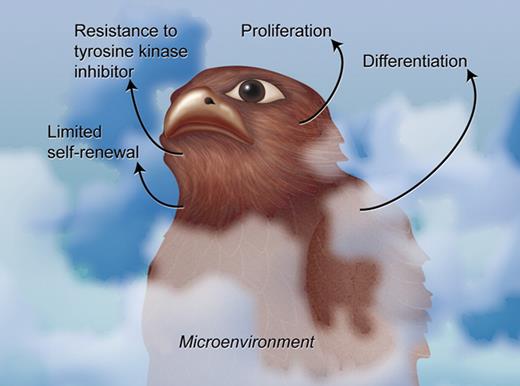Insights into cell stage–specific effects will shed light on pathogenesis and more successful therapies of BCR-ABL+ leukemias. In this issue of Blood, Schemionek and colleagues use a conditional BCR-ABL transgenic mouse model to identify properties of the CML-initiating cell.1
The Knights Templar of Malta paid tribute to Charles V of Spain by sending him a golden falcon encrusted with jewels. Pirates stole this priceless token and the fate of the Maltese Falcon remains a mystery, still invoked by films and novels.
The precise identity of the CML-initiating cell has been elusive, like the fictional Maltese Falcon. Properties of the CML-initiating cell include limited self-renewal, resistance to tyrosine kinase inhibitor, and ability to proliferate and differentiate. Professional illustration by A. Y. Chen.
The precise identity of the CML-initiating cell has been elusive, like the fictional Maltese Falcon. Properties of the CML-initiating cell include limited self-renewal, resistance to tyrosine kinase inhibitor, and ability to proliferate and differentiate. Professional illustration by A. Y. Chen.
Our story begins more than 150 years ago when John Hughes Bennett in Edinburgh and Rudolf Virchow in Berlin described, at autopsies, enlarged spleens in men who had been ill for 1 to 2 years and died after severe nosebleeds.2 Their blood appeared different. To Bennett, it looked like pus and he called it pyemia. To Virchow, it was white blood or leukemia (leukämie). We now call their subjects' condition chronic myeloid leukemia (CML). Since then, the abnormal chromosome has been identified, the affected genes isolated and characterized, mouse models created, and drugs approved.3 All have come together to truly make CML a chronic disease, not a fatal one.
No cancer is better understood at the molecular level than CML.4 Yet, like the fate of the Maltese Falcon, mysteries remain. Is Bcr-Abl the only genetic lesion required for chronic-phase CML? Can tyrosine kinase inhibitor therapy cure CML? How does p210 Bcr-Abl result in CML, but p190 in acute lymphoblastic leukemia? Why does the oncogenic Bcr-Abl promote proliferation and intact differentiation? Is there a dysfunctional relationship between the leukemic clone and its microenvironment? The CML-initiating cell lies at the heart of these mysteries (see figure).
By making a binary transgenic mouse where BCR-ABL expression is conditional upon withdrawal of tetracycline, the investigators created a mouse model that comes closest to mimicking human CML.5 Using their mouse model, they now report on properties of the CML-initiating cell: (1) CML-like disease is transplantable using LSK (lin-Sca-1+c-kit+) cells or unfractionated bone marrow; (2) leukemic granulocytes or progenitors do not initiate or enhance the CML-like disease; and (3) serial transplantation reduces the development of CML-like disease.
One finding of clinical value was that the transplantation of unfractionated bone marrow enhanced CML-like disease. This suggests that BCR-ABL induces differentiation of the CML stem cell belonging to the LSK compartment. By decreasing self-renewal capacity, BCR-ABL expression might be exploitable for therapy. How can clinicians modulate the administration of tyrosine kinase inhibitor therapy to better eliminate the CML-initiating cell? This mouse model provides the best available in vivo system to either fine-tune a single drug or design a more potent combination of agents. It may be further adapted by adding a genetic lesion that induces an accelerated phase or blast crisis, where a single tyrosine kinase inhibitor is not so effective and the need for a more effective combination of agents is great.
Part of their approach in phenocopying human disease was to use the 3′ enhancer of the murine stem cell leukemia (SCL) gene. Because the naturally occurring human 5′ regulatory elements of the BCR-ABL fusion gene could have different expression patterns in human hematopoietic and stromal cells, some of the observed properties may be approximate. Mice strains are highly inbred. The influences of epigenetics, polymorphisms, and noncoding RNAs are poorly understood in the context of mouse modeling of BCR-ABL+ disease.
Because Bcr-Abl sets off a chain reaction of complex signaling events, some of their conclusions may be approximate. For instance, their conclusion that Bcr-Abl differentiates the long-term hematopoietic stem cells may be due to other effects such as cellular senescence, oxidative stress, or metabolic exhaustion.6 The investigators also conclude that CML disease is cell autonomous. Still, murine hematopoietic stem cell compartments may not perfectly mimic human ones, and their stroma may behave or cooperate differently from that of human origin. The story has become more complex with identification of Hedgehog and Wnt/β-catenin in main taining CML-initiating cell stemness.7,8 These morphogens function within a defined environment or niche, as do leukemic cells.9 A multiscale analysis of Bcr-Abl in affecting hematopoietic cells at different stages of development and their interactions with the microenvironment and immune cells should yield a more accurate picture.
Perhaps the Maltese Falcon will never be found. Let us hope a different fate awaits the CML-initiating cell. Despite several caveats, this report does bring us much closer to finding, understanding, and eradicating the CML-initiating cell.
Conflict-of-interest disclosure: The author declares no competing financial interests. ■
REFERENCES
National Institutes of Health


This feature is available to Subscribers Only
Sign In or Create an Account Close Modal